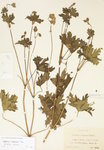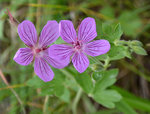

Oregon geranium (geranium oreganum) is about two feet tall and has large bright pink or purple flowers with prominent veins on the petals. These reflect UV light and help guide bumble bees to nectar at the base of the flower, much like runway lights help pilots land an airplane at night. Despite its size and showiness, this species has only been found once in Washington, and has not been seen again since 1936.
It is a prairie and oak woodland obligate species and is known primarily from the dry interior valley system that runs from southern British Columbia to northern California and includes the Puget Trough of Washington and Oregon’s Willamette Valley.
The last person to see this species in Washington was George Neville Jones, who at the time was a graduate student at the University of Illinois studying the geranium species of North America.
Jones made an herbarium collection and recorded his observation in a 1943 paper in the botanical journal Rhodora, noting the specimen was deposited at “UI.” Each major herbarium in North America has a unique two- or three-letter code to identify it. For years, no one could track down Jones’ specimen because “UI” is the code for a small herbarium in Uintah County, Utah. Some people began to question if Jones actually made his collection in Washington and whether the species ever occurred in the state.
Last year, Washington Natural Heritage Rare Plant Botanist Walter Fertig became interested in the case of the missing geranium. Walter tracked down the 1943 monograph. On the first page Jones, was identified as a graduate of the University of Illinois.
“It then occurred to me that “UI” was not the code for the Uintah County herbarium, but probably stood for the University of Illinois,” Walter recalls. “I searched some online databases but was unable to find the Jones specimen.”
Undeterred, Walter emailed David Seigler, the collections manager of the University of Illinois herbarium and asked if he could find the specimen. Seigler wrote back with good news: not only did he find the errant collection, but he sent a digital photograph of the specimen.
The label clearly indicates it came from “Mill Plain, Clark County, Washington.”
The image is of sufficient quality and the specimen can be positively identified as geranium oreganum.
Mystery solved — except no one has located Oregon geranium in Washington since Jones. If you are exploring wet prairie sites in Cowlitz, Clark, or Lewis counties, keep an eye out for a tall, showy, pink-flowered geranium – it might just be the mystery geranium.
This article was first published on “Ear to the Ground,” the official blog of the Washington State Department of Natural Resources. For more information on land care, go to dnr.wa.gov/urbanforestry.